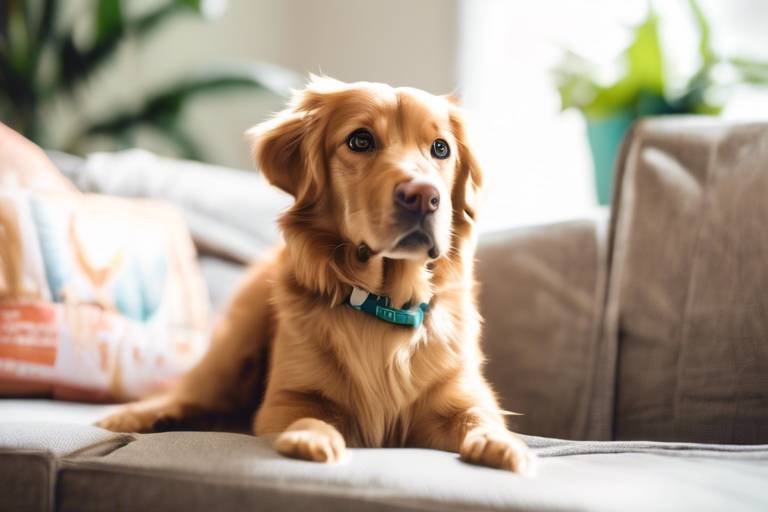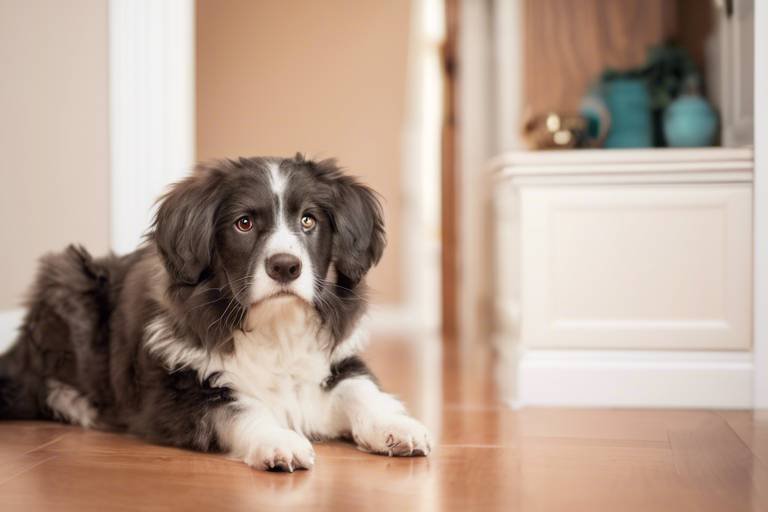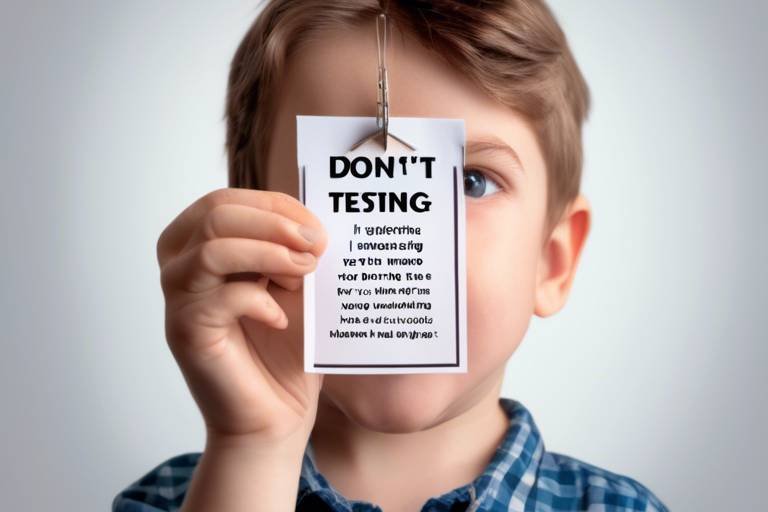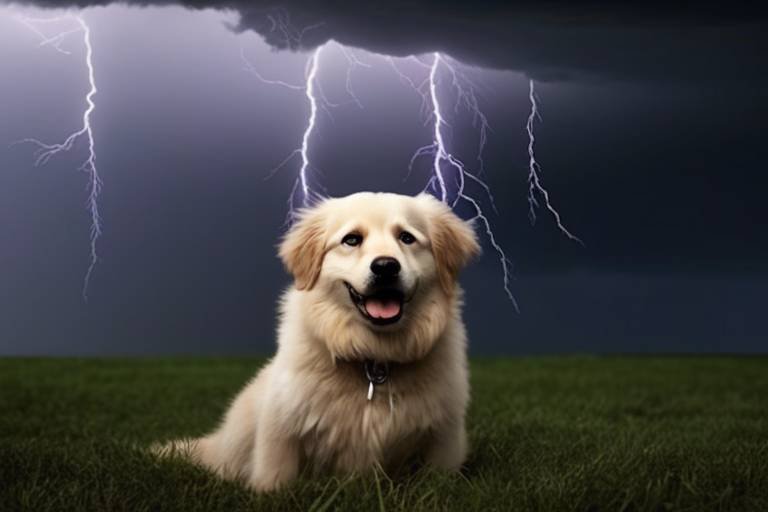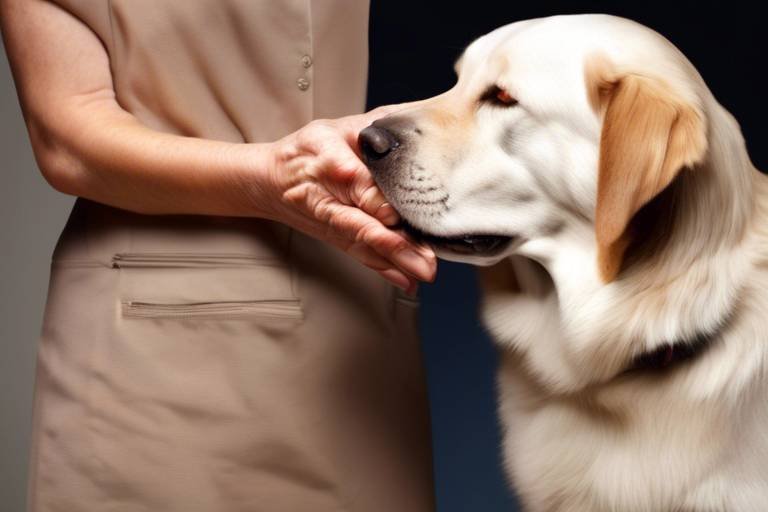How to Encourage Positive Behavior in Pets
Pets are more than just animals; they are cherished members of our families. Encouraging positive behavior in them not only enhances their well-being but also strengthens the bond we share. Imagine your furry friend wagging their tail, eagerly responding to your commands—it's a beautiful sight! But how do we get there? This article explores effective strategies for promoting positive behavior in pets, enhancing their well-being, and strengthening the bond between pets and their owners through training and positive reinforcement techniques.
Recognizing the natural instincts and behaviors of pets is essential for effective training. Just like humans, pets have their own personalities and quirks. For instance, dogs are pack animals and thrive on social interaction, while cats are often more independent and territorial. Understanding these traits can help you tailor your training methods to suit your pet's unique needs. When you consider how your pet's instincts influence their behavior, you can create a more effective training plan. For example, a dog that loves to chase might respond better to a game of fetch than to a sit command. By recognizing these behavioral traits, you can make your training sessions more engaging and productive.
Positive reinforcement is a powerful tool in pet training. It’s all about rewarding good behavior to encourage pets to repeat those actions. Think of it as a way to say, “Hey, you did great!” when your pet behaves well. This not only helps in training but also fosters a loving relationship between pets and their owners. The key here is to focus on what your pet does right rather than what they do wrong. When they see that good behavior leads to rewards, they are more likely to repeat it. This approach transforms training from a chore into a fun and rewarding experience for both you and your pet!
Different pets respond to various types of rewards. Here are some effective motivators:
- Treats: Food rewards can be highly effective, especially for food-driven pets.
- Praise: Verbal praise can reinforce positive actions and help pets feel appreciated.
- Play: Engaging in playtime can be a fantastic reward, especially for active pets.
Using treats as rewards can be highly effective, but it's important to choose healthy options. Think of treats as tiny tokens of appreciation. When selecting treats, opt for those that are low in calories and made from wholesome ingredients. Timing is also crucial; reward your pet immediately after they exhibit the desired behavior. This way, they can connect the dots between their action and the reward, making the learning process clearer and more effective.
Verbal praise can significantly impact your pet's motivation and behavior. Imagine your pet's ears perking up when they hear your enthusiastic voice! Using a cheerful tone and expressive language can make your pet feel valued. When they perform a good action, say things like, “Good boy!” or “You’re such a clever girl!” Your tone can convey your excitement and approval, making your pet eager to please you in the future.
Consistency is key to successful training. Just like learning a new language, repetition and regular practice help solidify knowledge. Maintain a regular training schedule and use the same commands to avoid confusing your pet. If you say “sit” one day and “down” the next, your pet may become perplexed. By being consistent, you create a clear understanding of expectations, which leads to quicker learning and better behavior.
Socializing pets effectively is crucial for their development. Exposing them to different environments, people, and other animals helps promote positive interactions and reduces anxiety. Think of socialization as a way to broaden your pet's horizons. The more experiences they have, the more adaptable and confident they become.
Participating in group classes can enhance social skills. These classes provide a supportive learning environment where pets can interact with others while learning essential commands. Imagine your dog making new friends while mastering the “stay” command! Group classes also allow owners to share experiences and tips, making the training journey more enjoyable.
Arranging playdates can improve social behavior. Structured playtime with other pets helps develop important social skills and reduces behavioral issues. It’s like a mini-party for your pet! Just ensure that the playmates are well-matched in size and temperament to keep things safe and fun. With time, your pet will learn how to interact positively with others, leading to a well-adjusted and happy companion.
Q: How long should training sessions last?
A: Training sessions should be short and engaging, ideally lasting 5-10 minutes. This keeps your pet focused and prevents boredom.
Q: What if my pet doesn’t respond to rewards?
A: Every pet is unique. Try different types of rewards, such as toys or extra playtime, to see what motivates your pet best.
Q: Can I use negative reinforcement?
A: While some trainers use negative reinforcement, it’s generally more effective to focus on positive reinforcement techniques, as they foster a better bond between you and your pet.

Understanding Pet Behavior
Understanding pet behavior is like unlocking a treasure chest filled with insights that can strengthen the bond between you and your furry friend. Every pet, whether it's a dog, cat, or even a rabbit, has its own unique set of instincts and behaviors that stem from their ancestry and environment. By diving deep into these behaviors, you can tailor your training methods to suit their needs, making the process smoother and more enjoyable for both of you.
For instance, dogs are pack animals by nature, which means they thrive on social interactions and often look to their human companions for guidance. This innate desire to belong can be harnessed during training sessions. On the other hand, cats are more independent and may exhibit behaviors that seem aloof. Understanding that they are natural hunters can help you create engaging play sessions that stimulate their instincts while reinforcing positive behavior.
Here are some common behavioral traits to consider:
- Territorial Instincts: Many pets, especially dogs, can be territorial. Recognizing this can help you manage their reactions to new people or animals.
- Socialization: Pets that are well-socialized tend to be more confident and less anxious. Early exposure to different environments and situations is vital.
- Attention-Seeking Behaviors: Pets often engage in certain behaviors to get your attention. Understanding these can help you respond appropriately without reinforcing negative actions.
By recognizing these traits, you can better interpret your pet's actions and respond accordingly. For example, if your dog barks excessively when someone approaches your home, it may be a sign of protective behavior rather than aggression. Understanding this distinction allows you to train them to respond more appropriately without stifling their natural instincts.
Moreover, it's essential to be aware of the body language of your pets. Signs of stress, fear, or excitement can be communicated through their posture, tail position, and vocalizations. For example, a wagging tail doesn't always mean a dog is happy; it can also indicate anxiety or agitation. By observing these signals, you can adjust your training techniques and create a more comfortable environment for your pet.
In summary, understanding pet behavior is crucial for effective training and fostering a positive environment. By tapping into their natural instincts and recognizing their unique traits, you can communicate better with your pets, leading to a harmonious and loving relationship.

Positive Reinforcement Techniques
When it comes to training our furry friends, positive reinforcement stands out as one of the most effective techniques. Imagine your pet as a little sponge, soaking up everything you teach them. By rewarding good behavior, you not only encourage them to repeat those actions but also strengthen the bond you share. It's like a dance; when you lead with positivity, your pet will follow your rhythm. So, let’s dive into the different methods you can use to reward your pet and create a harmonious relationship.
One of the most rewarding aspects of using positive reinforcement is the variety of ways you can express it. It’s not just about giving treats; it’s about understanding your pet’s unique personality and what makes them tick. For some pets, a tasty treat might be the ultimate motivator, while for others, a game of fetch or a simple pat on the head might do the trick. The key is to discover what your pet responds to best. Here are some common types of rewards you can consider:
- Treats: Food rewards are often the quickest way to get your pet’s attention. Think of it as a delicious bribe!
- Verbal Praise: Your enthusiastic "Good boy!" or "Well done!" can be incredibly uplifting for your pet.
- Playtime: Engaging in their favorite game can be a fantastic reward for a job well done.
Now, let’s talk specifics. When using food rewards, it’s essential to choose healthy options. Think about it: you wouldn’t want to reward your pet with junk food, right? Opt for small, nutritious treats that won’t upset their stomach. Timing is also crucial; reward your pet immediately after they exhibit the desired behavior. This helps them make the connection between the action and the reward. For instance, if your dog sits on command, give them a treat right then and there. It’s all about that instant gratification!
Next up is verbal praise. Did you know that your tone of voice can significantly impact your pet’s motivation? Using an upbeat and enthusiastic tone can make your pet feel like they’ve just won the lottery! This emotional boost can encourage them to repeat the behavior you’re praising. So, don’t hold back; let your excitement shine through. Imagine how you would feel if someone cheered you on for a job well done—it’s uplifting, right?
Lastly, consistency is key in any training regimen. Make sure to maintain a regular training schedule and use the same commands every time. This practice helps your pet understand exactly what you expect from them. If you’re inconsistent, it’s like trying to learn a new dance without a steady beat; it just won’t work! By being consistent, you provide a clear framework for your pet, making it easier for them to succeed and receive those well-deserved rewards.
In conclusion, employing positive reinforcement techniques is a game-changer in pet training. By using a combination of treats, praise, and play, and ensuring consistency, you can foster an environment where your pet feels loved and motivated to learn. Remember, training should be a fun and rewarding experience for both you and your furry companion!
Types of Rewards
When it comes to encouraging positive behavior in pets, understanding the different you can use is crucial. Every pet is unique, and what works for one might not work for another. The key is to find the right motivator that resonates with your furry friend. Let's dive into the most effective rewards that can help you foster good behavior in your pets.
One of the most popular forms of reward is food rewards. Treats are like gold stars for pets; they love them! However, it’s essential to choose healthy options. Think of it this way: would you prefer a candy bar every day or a delicious piece of fruit? The same goes for your pets. Healthy treats not only keep them fit but also make training sessions more enjoyable. Timing is everything, too. The moment your pet performs the desired action, that’s when you should present the treat. This immediate reward helps them make the connection between their behavior and the reward.
Next up is verbal praise. Believe it or not, your voice can be a powerful tool in training. When you use a cheerful tone and enthusiastic words, it’s like giving your pet a warm hug. They thrive on your approval! Imagine how you feel when someone cheers you on; it’s a confidence booster, right? Similarly, your pet will feel encouraged and motivated to repeat the good behavior. Just remember, consistency is key. If you use a specific phrase like “Good boy!” or “Well done!” stick to it. This consistency will help your pet understand what behaviors you’re praising.
In addition to food and verbal praise, playtime can also serve as an excellent reward. For many pets, especially dogs, a game of fetch or a fun tug-of-war session can be more enticing than a treat. It’s not just about the reward; it’s also about the bonding experience. Engaging in play helps reinforce the positive behavior while also strengthening your relationship. So, don’t underestimate the power of a good game!
To summarize, here are the main types of rewards you can use to encourage positive behavior in your pets:
- Food Rewards: Healthy treats that are given immediately after the desired behavior.
- Verbal Praise: Using a cheerful tone and consistent phrases to encourage your pet.
- Playtime: Engaging in fun activities that not only reward good behavior but also strengthen your bond.
Finding the right mix of these rewards can turn training sessions into a fun and rewarding experience for both you and your pet. By understanding what motivates your furry friend, you’ll be well on your way to promoting positive behavior that lasts.
Food Rewards
Using treats as rewards can be highly effective in shaping your pet's behavior. Imagine this: you’ve just taught your dog to sit on command, and as soon as his little bottom touches the ground, you whip out a tasty treat. That look of excitement on his face? Priceless! But here’s the kicker—choosing the right treats is crucial for your pet's health and motivation. Opt for healthy snacks that are low in calories but high in flavor. Think about it as a reward system; you wouldn’t want to spoil your pet by giving them junk food every time they do something right. A well-balanced treat can keep them sprightly and eager to learn.
Timing is everything when it comes to rewarding your pet. You want to give that treat immediately after they perform the desired action, creating a clear connection between their behavior and the reward. This technique is often referred to as immediate reinforcement. For example, if your cat uses her scratching post instead of the couch, don’t wait until later to give her a treat. The sooner, the better! This instant gratification helps your pet understand what behavior you’re encouraging.
Moreover, it's essential to vary the types of food rewards you use. Just like humans, pets can get bored with the same old thing. Keep them on their toes by switching between different types of treats. Here are some categories to consider:
- Commercial Treats: These are specifically designed for pets and often come in various flavors.
- Homemade Treats: You can whip up some simple recipes that are both tasty and nutritious.
- Fruits and Vegetables: Small pieces of apple, carrot, or pumpkin can be delightful and healthy options.
Finally, remember that moderation is key. While food rewards are effective, too many can lead to weight gain and health issues. Always keep an eye on your pet's overall diet and adjust their meals accordingly. This balance not only encourages positive behavior but also promotes a healthy lifestyle. So, the next time you think about rewarding your furry friend, remember: a little treat goes a long way when it comes to training!
Q: Can I use my pet's regular food as a reward?
A: Absolutely! Just make sure to adjust their meal portions to account for the extra calories.
Q: How often should I reward my pet?
A: Initially, reward them every time they perform the desired behavior. As they learn, you can start to space out the rewards.
Q: What if my pet is not motivated by treats?
A: Some pets respond better to verbal praise or playtime, so it’s worth experimenting to find what motivates them.
Verbal Praise
When it comes to training pets, is one of the most effective yet often overlooked tools in our arsenal. Imagine this: you just got home from a long day, and your furry friend greets you with wagging tails or soft purrs. They’ve been waiting for you, and now it’s your turn to show them just how much you appreciate their good behavior. Using your voice to express joy and approval can create a strong bond between you and your pet. But how do you do it effectively?
First off, it’s essential to understand that not all pets respond the same way to verbal cues. Some may perk up at a high-pitched, enthusiastic tone, while others might prefer a calm and soothing voice. The key is to find what makes your pet tick. For instance, when your dog sits on command, you might say, “Good boy!” in an excited tone. This not only makes your pet feel good but also encourages them to repeat the behavior. Think of your voice as a musical instrument; the right notes can create a beautiful melody that motivates your pet.
Furthermore, timing is everything! Just like a well-timed joke gets the best laugh, delivering verbal praise at the right moment can enhance its effectiveness. If your dog rolls over after you ask, don’t wait until the trick is completed to praise them. Instead, give them that enthusiastic “Yes!” or “Good job!” the moment they start the action. This immediate feedback helps your pet associate the desired behavior with the positive reinforcement of your praise.
Here are a few tips to make your verbal praise even more impactful:
- Be Consistent: Use the same phrases and tones for specific actions to avoid confusion.
- Use Enthusiasm: Let your excitement shine through! Pets can sense your energy.
- Vary Your Praise: Mix it up! Use different words or phrases to keep things fresh and engaging for your pet.
Incorporating verbal praise into your training routine not only reinforces good behavior but also strengthens your relationship. It’s a simple yet powerful way to communicate love and appreciation, making your pet feel valued and understood. So, the next time your pet does something right, don’t just give them a treat; give them a hearty round of applause with your voice. After all, who doesn’t love a little recognition?
Q: Can verbal praise be used for all types of pets?
A: Yes! Most pets, including dogs, cats, and even some small animals, respond positively to verbal praise. Tailor your tone and words to suit your pet’s personality.
Q: How can I tell if my pet enjoys verbal praise?
A: Look for signs of excitement, such as wagging tails, perked ears, or approaching you for more interaction. If they seem happy and engaged, they likely enjoy it!
Q: Is verbal praise enough on its own for training?
A: While verbal praise is a fantastic tool, combining it with other methods, such as treats or play, can enhance the training experience and effectiveness.
Consistency in Training
When it comes to training your beloved pet, consistency is the name of the game. Imagine trying to learn a new language where the rules change every time you open your textbook. Frustrating, right? That’s exactly how your pet feels if you’re not consistent with commands and training routines. To foster a smooth learning experience, it’s crucial to maintain a regular schedule and use the same commands every time. This helps to build a clear understanding of what you expect from them.
Let’s break it down a bit more. First off, establishing a training routine can be incredibly beneficial. Whether it’s a morning session before breakfast or an evening wind-down after a long day, having a set time for training can help your pet anticipate and prepare for these moments. Just like humans, pets thrive on routine; it makes them feel safe and secure. When they know it’s training time, they’ll be more focused and eager to learn.
Moreover, using the same commands consistently is essential. For example, if you want your dog to sit, always use the word “sit” rather than switching it up with “down” or “stay” on different occasions. This can cause confusion and lead to frustration for both you and your pet. To illustrate, here’s a quick comparison:
| Inconsistent Commands | Consistent Commands |
|---|---|
| “Come here!” / “Get over here!” | “Come!” |
| “Sit down!” / “Take a seat!” | “Sit!” |
| “Lay down!” / “Lie down!” | “Down!” |
As you can see, consistency not only aids in clarity but also builds trust. When your pet knows what to expect, they feel more secure in their environment. This trust is vital for a strong bond between you and your furry friend. Plus, it makes training a lot more fun! Your pet will be more engaged when they understand what you want from them.
Another important aspect of consistency is rewarding good behavior immediately after it occurs. Timing is everything! If you wait too long to reward your pet, they might not connect the dot between their action and the reward. This can lead to confusion and a lack of motivation. So, if your dog sits on command, give them a treat right away. If your cat uses the scratching post instead of the couch, shower them with praise immediately. This reinforces the behavior and encourages them to repeat it.
In summary, being consistent in training your pet is crucial for their understanding and your success as a pet owner. By sticking to a routine, using the same commands, and rewarding good behavior promptly, you’ll create a positive training environment that enhances your pet’s learning experience. Remember, patience and persistence are key, so keep at it! Your efforts will pay off in the long run, leading to a well-behaved and happy companion.
- How long should training sessions last? Training sessions should ideally be short and engaging, around 5 to 10 minutes, to maintain your pet's focus and enthusiasm.
- Can I train my pet at home? Absolutely! Home training can be very effective, especially with a consistent routine and a distraction-free environment.
- What if my pet doesn’t respond to commands? If your pet isn’t responding, it could be due to inconsistency, distractions, or even health issues. Consider consulting a professional trainer or veterinarian if needed.

Socialization Strategies
Socializing your pet is not just about letting them frolic in the park; it’s a vital part of their development that can significantly influence their behavior and temperament. Think of socialization as giving your pet a passport to the world around them. When pets are exposed to a variety of environments, people, and other animals, they learn to navigate different social situations with confidence, reducing the likelihood of anxiety or aggression. Just like us, pets thrive in environments where they feel secure and understood.
One effective way to enhance your pet's social skills is through group training classes. These classes provide a structured environment where pets can interact with others while learning essential commands and behaviors. It's like a classroom for furry friends! In these sessions, pets not only learn from their trainers but also from observing and interacting with their peers. This can be particularly beneficial for shy or anxious pets, as they get to see that other animals are friendly and approachable.
Another fantastic strategy is arranging playdates with other pets. Think of it as a social mixer for your pet! Structured playtime allows pets to engage in natural behaviors, such as chasing and wrestling, which are crucial for their emotional and physical health. During these playdates, pets learn boundaries and how to communicate effectively with their peers. It’s essential to monitor these interactions closely, especially in the beginning, to ensure that all pets feel safe and comfortable. By facilitating these positive experiences, you’re helping your pet build a solid foundation for future interactions.
To ensure your pet gets the most out of these socialization strategies, consider the following tips:
- Start socialization early: The earlier your pet is exposed to different situations, the better adjusted they will be.
- Keep experiences positive: Always associate new experiences with positive outcomes, like treats or praise.
- Gradually increase exposure: Start with less stimulating environments and gradually introduce your pet to busier spaces.
In conclusion, socialization is a crucial aspect of pet ownership that fosters a happy, well-adjusted pet. By utilizing group training classes and arranging playdates, you not only enhance your pet's social skills but also strengthen the bond you share. Remember, a well-socialized pet is a happy pet, and the effort you put into their socialization will pay off in the long run!
Q: How early should I start socializing my pet?
A: It's best to start socializing your pet as early as possible, ideally during their critical developmental period, which is typically between 3 to 14 weeks old for puppies and kittens.
Q: What if my pet is fearful or aggressive towards other animals?
A: If your pet shows signs of fear or aggression, it's important to seek help from a professional trainer or behaviorist who can guide you through the socialization process safely.
Q: How often should I arrange playdates for my pet?
A: Regular playdates are beneficial, but the frequency can vary based on your pet's comfort level. Start with once a week and adjust as needed.
Group Training Classes
Group training classes are a fantastic opportunity for both pets and their owners to learn and grow together. Imagine a bustling room filled with wagging tails and enthusiastic barks, where each pet is eager to show off their new skills. These classes not only teach essential commands but also provide a social setting that can significantly enhance your pet's social skills. In a group environment, pets learn to interact with other animals and people, which is crucial for their overall development.
One of the most significant benefits of group training classes is the sense of community they foster. Owners often find themselves exchanging tips and experiences, creating a supportive network that extends beyond the classroom. This camaraderie can be incredibly beneficial, especially for first-time pet owners who may feel overwhelmed. Plus, watching other pets learn can motivate your own furry friend to engage and participate actively.
In these classes, professional trainers employ various techniques to ensure that each pet receives the attention they need. Typically, the classes are structured to cover a range of skills, from basic obedience commands like "sit" and "stay" to more advanced tricks. The trainers often use positive reinforcement methods, which means that pets are rewarded for their good behavior, making the learning process enjoyable and effective.
Moreover, group training classes can help alleviate behavioral issues that stem from anxiety or fearfulness. By exposing pets to new experiences in a controlled environment, they learn to feel more comfortable in the presence of other animals and people. This exposure can lead to a more confident and well-adjusted pet. It's like taking your shy friend to a party; with a little encouragement, they might just become the life of the party!
To give you a clearer picture of what to expect, here’s a brief overview of the typical structure of a group training class:
| Class Component | Description |
|---|---|
| Warm-Up | Short exercises to get pets comfortable and engaged. |
| Basic Commands | Focus on essential commands like "sit," "stay," and "come." |
| Socialization Exercises | Controlled interactions with other pets to build confidence. |
| Advanced Tricks | Teaching fun tricks to keep pets mentally stimulated. |
| Cool Down | Relaxation time and recap of what was learned. |
In conclusion, group training classes are an invaluable resource for pet owners looking to enhance their pet's behavior and social skills. By participating in these classes, you not only improve your pet's obedience but also strengthen the bond between you and your furry companion. So why wait? Find a class near you and watch your pet thrive in a fun, supportive environment!
- What age should my pet start attending group training classes?
Most trainers recommend starting as early as 8 weeks old, but it's never too late to learn! - How long do group training classes typically last?
Classes usually run for about an hour, once a week, for several weeks. - Can I attend a class with my pet if they have behavioral issues?
Yes! Many trainers specialize in helping pets with behavioral challenges. - What should I bring to a group training class?
Bring your pet's favorite treats, a leash, and any necessary training equipment.
Playdates with Other Pets
Arranging playdates for your pets can be one of the most enjoyable and beneficial experiences for both them and you. Just like humans, pets thrive on social interaction, and what better way to foster their social skills than by spending time with other furry friends? Think of it as a little party where your pet can let loose, explore, and make new friends. Imagine the joy on your dog's face when they see their buddy running towards them, tails wagging and excitement in the air!
When planning a playdate, there are several factors to consider to ensure that both pets have a great time. First, it's crucial to match pets based on their size, energy levels, and temperaments. For instance, a calm, older dog might feel overwhelmed by a hyperactive puppy. To make the most out of these interactions, you might want to consider the following:
- Choose the Right Location: Select a safe, enclosed space where the pets can play freely without the risk of escaping or encountering dangerous situations. Dog parks, backyards, or even a living room can work well!
- Supervise Playtime: Always keep an eye on the pets during their playdate. This not only ensures their safety but also allows you to intervene if play becomes too rough or if one pet seems uncomfortable.
- Have Toys Ready: Bring along some toys to keep the playdate lively. However, be mindful of sharing – some pets can be possessive over their toys!
Another wonderful aspect of playdates is the opportunity for training. You can use these sessions to reinforce good behavior in your pet. For example, if your dog tends to jump on people, you can work on commands like "sit" or "stay" while they are distracted by their playmate. This not only helps in training but also teaches your pet how to interact appropriately with others.
Moreover, playdates can significantly reduce behavioral issues. Pets that are well-socialized are less likely to develop anxiety or aggression towards unfamiliar animals or people. They learn how to communicate and understand body language, which is essential for their overall emotional health. So, if your pet has been a bit too barky or anxious lately, a playdate could be the perfect remedy!
In conclusion, playdates with other pets are not just fun; they are a vital part of your pet's social development. By facilitating these interactions, you are helping your furry friend lead a happier, more balanced life. So, grab that leash, call up a friend with a pet, and let the playdates begin!
Q: How often should I arrange playdates for my pet?
A: It depends on your pet's personality and energy levels. Some pets thrive on frequent social interactions, while others may prefer less frequent playdates. Aim for at least once a week if possible!
Q: What if my pet doesn't get along with other animals?
A: If your pet shows signs of aggression or fear towards other animals, it's essential to work on their socialization skills gradually. Start with one calm and friendly pet and monitor their interactions closely.
Q: Can playdates help with my pet's anxiety?
A: Yes! Regular playdates can help reduce anxiety by providing your pet with positive social experiences. It teaches them how to cope with new situations and builds their confidence.
Frequently Asked Questions
- What is positive reinforcement in pet training?
Positive reinforcement is a training method that involves rewarding your pet for good behavior. This can include treats, praise, or playtime, encouraging them to repeat those actions. It's all about creating a positive association with the behaviors you want to promote!
- How can I choose the right rewards for my pet?
Choosing the right rewards depends on your pet's preferences. Some pets respond better to food treats, while others might prefer verbal praise or playtime. Experiment with different options to see what motivates your furry friend the most!
- How often should I train my pet?
Consistency is key! It's best to have short, regular training sessions rather than long, infrequent ones. Aim for daily practice sessions of about 5 to 10 minutes. This keeps your pet engaged and helps reinforce learning without overwhelming them.
- Why is socialization important for pets?
Socialization helps pets become well-adjusted adults. Exposing them to various environments, people, and other animals can reduce anxiety and prevent behavioral issues. Think of it as giving your pet a toolkit for navigating the world confidently!
- What are the benefits of group training classes?
Group training classes provide a fantastic opportunity for pets to socialize while learning. They also help owners connect with others facing similar challenges. Plus, the presence of distractions in a group setting can enhance your pet's focus and learning!
- How can playdates help my pet's behavior?
Arranging playdates with other pets can significantly improve your pet's social skills. These structured interactions allow them to learn appropriate play behavior and reduce anxiety around other animals, making them more comfortable in various situations.


